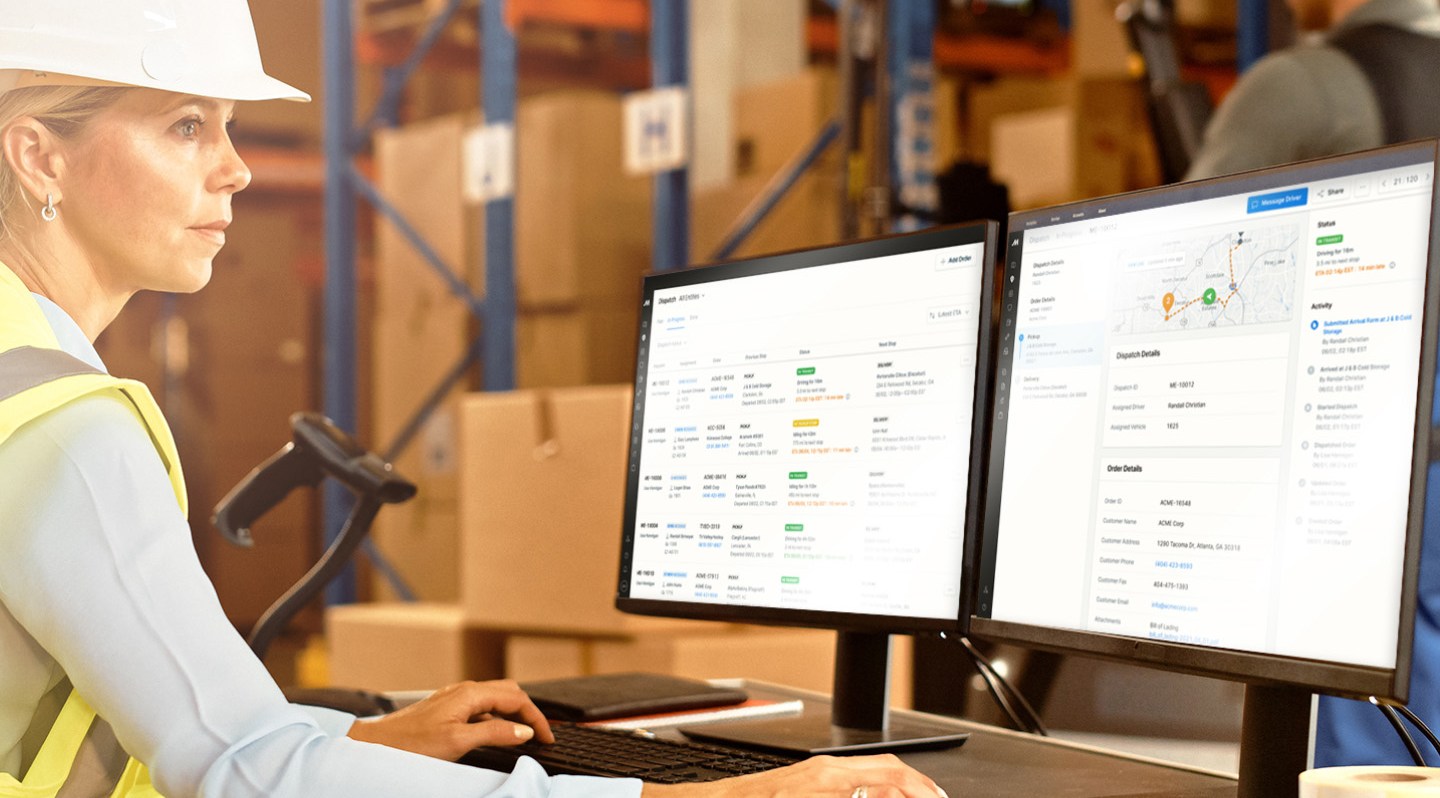In today’s fast-paced world, businesses with large vehicle fleets face numerous challenges. Optimizing routes, coordinating schedules, and ensuring timely deliveries is complicated. Fleet dispatch software is a powerful solution to help streamline operations and enhance efficiency. In this article, we’ll discuss fleet dispatch software and how it can drive productivity and profitability while helping fleets deliver the best customer service possible.
What is fleet dispatch software?
Fleet dispatch software provides tools and features to efficiently assign, track, and manage vehicles and drivers. It provides a centralized hub to connect dispatchers or fleet managers with drivers and other stakeholders.
Dispatchers can view the status and availability of vehicles and drivers in real time and facilitate efficient assignment based on factors such as location, vehicle type, and availability. Route planning and optimization capabilities can also make it easier to calculate the most efficient routes based on various parameters such as distance, traffic conditions, or delivery priorities. This can help reduce fuel consumption, minimize travel time, and improve overall efficiency.
Fleet dispatch software should integrate with GPS or telematics systems to provide accurate vehicle tracking and monitoring. The platform should also provide channels for dispatchers and drivers to easily exchange information to facilitate real-time updates, instructions, and coordination.
In the next section, we’ll discuss the advantages of comprehensive software in more detail.
7 benefits of fleet dispatch software
Transportation logistics providers aren’t the only ones to benefit from all-in-one dispatch and fleet management software. Delivery, food and beverage, oil and gas, construction, and many other industries can enjoy these seven advantages of fleet dispatch software.
1. Streamline communication
Fleet dispatch software offers instant communication channels between dispatchers and drivers, reducing reliance on phone calls or radio communication. Real-time messaging and notifications ensure efficient information flow and prompt response to changes or emergencies.
The online channels also make it easier for managers or drivers to provide feedback. This can support improved road safety via targeted coaching and training.
2. Efficient routing and scheduling
With advanced algorithms, fleet dispatch software optimizes routes and schedules based on factors like traffic, delivery windows, and vehicle availability. This minimizes mileage, reduces fuel consumption, and maximizes the number of deliveries per day.
The ability to view dispatch history and reports can also help cut the idling time from vehicles encountering traffic or toll booths, having to wait during loading and unloading at suppliers’ or customers’ premises, or needing to process paperwork.
3. Real-time tracking and monitoring
Fleet dispatch software provides real-time GPS tracking, allowing dispatchers to monitor vehicle locations, speed, and status. This enables proactive decision-making, improved customer service, and increased security.
Instead of calling drivers to get ETA updates, fleet managers can use GPS tracking to locate assets. This reduces driver distractions and saves managers from coming across as micro-managers.
4. Automated dispatching
The software automates manual tasks in the dispatching process by intelligently assigning jobs to available drivers based on predefined rules. Automation can also handle a larger volume of jobs, considering a greater number of factors simultaneously. This frees up fleet managers to focus instead on safety, compliance, and improving the business bottom line while ensuring fair distribution of workload. Meanwhile, drivers are better positioned to complete their deliveries more efficiently.
Southland Steel Fabricators’ logistics manager Gary Overturf estimates Motive’s dispatch automation saves him 40 hours per month. “Motive frees up so much of my time for higher-value work,” he says. “We’re about to double our amount of drivers, and it’s going to be a dream dispatching these trucks with Motive.”
5. Route optimization
Fleet dispatch software optimizes routes by considering multiple variables such as traffic, weather conditions, and delivery priorities. It suggests the most efficient paths, minimizing fuel consumption and reducing travel time.
The software also helps fleets avoid assigning loads with unrealistic timeframes, which can help strike a better balance between profits and driver retention.
6. Improve customer experience
Effective communication with customers is vital in fleet management. Cloud-based fleet dispatch software can provide features like real-time updates with accurate ETAs and delivery confirmation. This transparency can improve customer satisfaction and strengthen relationships.
Some solutions, like Motive’s fleet dispatch solution, can even send ETAs directly to customers to further streamline your operations.
7. Performance analytics
Fleet dispatch software can also offer robust reporting and analytics capabilities. Integrating the software with telematics data generates powerful insights into key performance metrics like delivery times, driver efficiency, and fuel consumption. These analytics can help businesses identify areas for improvement while increasing efficiency and productivity and reducing operational costs.
Features to look for in fleet dispatch software
To get the most out of fleet dispatch software, it helps to look for robust capabilities for managing a fleet of vehicles and assets. Seek features and functions such as:
- Asset profiles for individual drivers, vehicles, and other assets. Simplify availability tracking and scheduling, and assigning drivers to specific vehicles.
- Real-time tracking and monitoring. Provide dispatchers with a clear view of the fleet’s location, status, and progress.
- Process automation. Optimize the assignment of vehicles and drivers based on factors like proximity, availability, skill set, and priority.
- Communication tools. Facilitate clear and timely information exchange between dispatchers and drivers and optimize workflow.
- Route planning and optimization features. Reduce waste, cut costs, and ensure on-time delivery considering factors like traffic conditions, distance, and delivery priorities.
- Analytics with comprehensive reporting. Enables managers to generate reports on KPIs and identify trends or areas for improvement.
- Integration with other systems or tools you use. Integrations such as fuel or fleet spend management systems support seamless data flow and avoid duplicate data entry.
Choosing the right dispatching software
When selecting fleet dispatch software, first identify your specific needs and goals. Consider your fleet size, industry, compliance needs, and any other unique requirements. Having created a list of essential features and functionalities needed, consider the following:
- Scalability and customization. Choose software that can accommodate fleet growth and adapt to changing business needs. Customization can help tailor the software to the fleet’s specific needs.
- Integration. Look for software that integrates with other fleet management systems. Consolidating telematics, fuel tracking, and maintenance software, for instance, can avoid silos and improve decision-making.
- Ease of use. An intuitive interface that’s easy to navigate and understand will maximize adoption rates. Minimizing training requirements with a user-friendly interface can also support a more successful roll-out of the software solution.
- Mobility. A cloud-based dispatch software enables dispatchers and drivers to stay connected and access critical information on the go.
- Customer support. Look at reviews and customer feedback to evaluate the quality and availability of customer support the software vendor provides.
Implementing fleet dispatch software
Any change to fleet operations will go smoother with careful advance planning. Support a successful implementation of new fleet dispatch software by first developing a comprehensive plan for the change. Before implementing the software, communicate to stakeholders the reason for the change and its benefits. Ensure the necessary parties understand the timeline and resource requirements.
Another important step is to thoroughly train dispatchers and drivers on the software’s features and functionalities. This should also be treated as an opportunity to communicate the value of the change and its advantages. It can help to have a few drivers and dispatchers on board with the plan before introducing it to the entire fleet to help ensure a smooth transition.
Test and verify data accuracy and functionality before going live across the fleet. Then, during the actual transition, move cautiously. Doing away with existing processes overnight can undermine implementation success.
Remember to provide ongoing support. Make sure people know where to turn for help in addressing any issues or questions that may arise during software usage.
Why Motive for dispatch and workflow software
Fleet dispatch and workflow software offers real-time insights and enables instant and efficient communication to optimize routes, minimize disruptions, and reduce fuel costs. By selecting the right dispatching software, planning for implementation, and providing ongoing support, companies can optimize their fleet management processes and stay ahead in today’s competitive market.
Motive’s fleet dispatch software can help transform operational safety, productivity, and profitability. See why small businesses and Fortune 500 enterprises use Motive Dispatch to help organize, assign, and optimize for on-time deliveries. Contact us to get started now.





